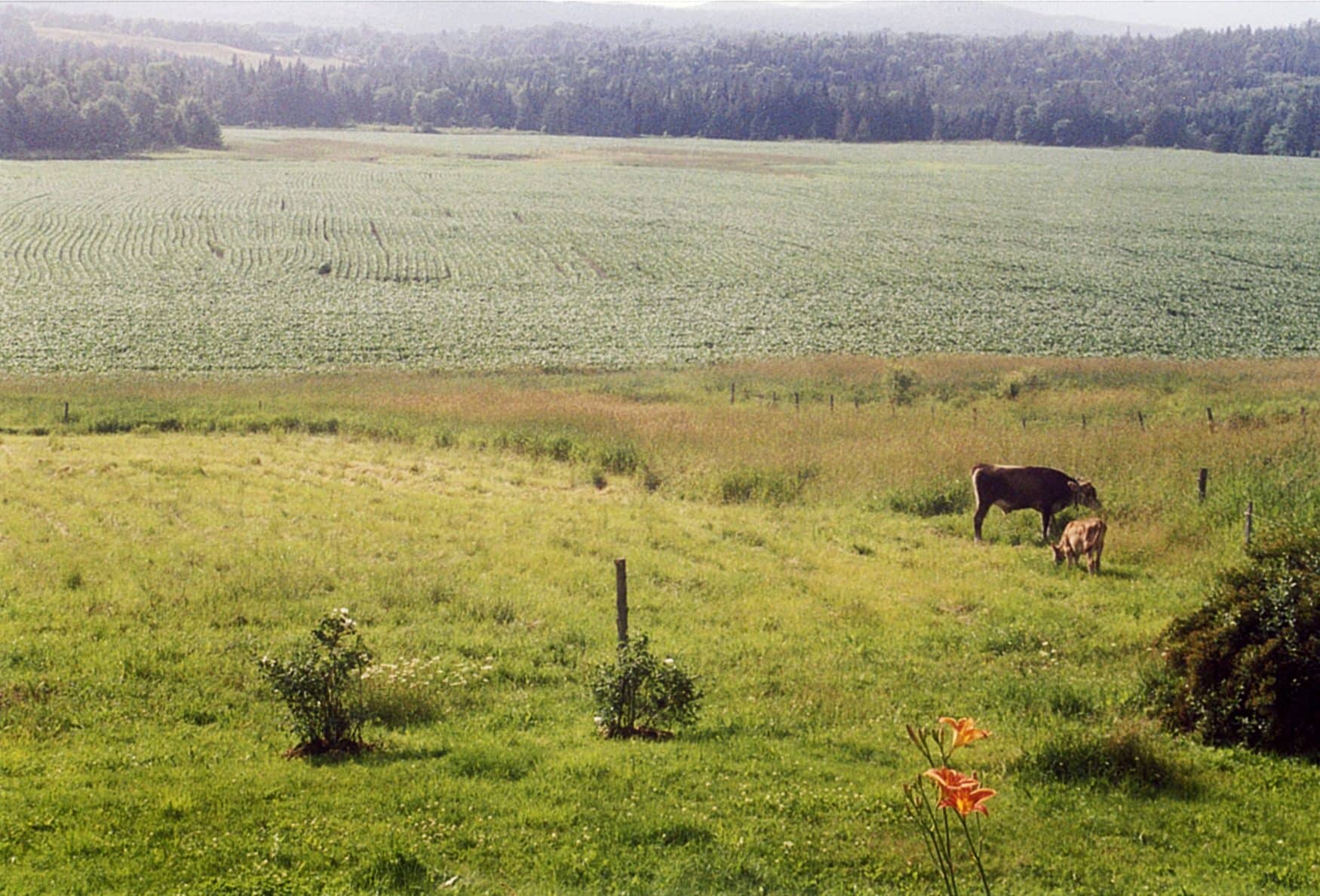A Cow Named Penny | The Farmer’s Life: Dispatches from Chickadee Farm in Craftsbury, Vermont
I desperately wanted a cow, but what I got was a lot more than I ever expected.

Coffee By Design | Portland, Maine
Photo Credit : Katherine KeenanIt is unquestionably easier to pick up a gallon of milk at the store than it is to sit on a stool and hand-milk one’s own cow.
And yet for a half a dozen years I pursued this unreasonable dream. When I moved to Vermont 20 years ago, there were more than 2,000 dairy farms, and, consequently, there were 2,000 dairy farmers. And for a spell, I dated one of them.
When that romance kicked the bucket, I endeavored to live an agricultural life on my own, and, thanks to everything I’d learned from the dairyman, I knew my future would include bovines.
On my own, over the course of seven years, I raised three cows (Penny, Belle, and Frannie) and three steers (Beauregard, Calftan, and Franklin). Courtesy of my herd, I had milk and manure for the garden; thanks to the steers, I had meat.
But it was far from easy. After a series of difficulties, I sold off my last cow and promised myself that I would put the bovine dream aside until I married.
As luck would have it, four years after that vow, I married a man who consumes about four gallons of milk a week. And so, as we now consider the prudence of acquiring a Jersey to milk, I’ve been revisiting the memory of my first cow, Penny, as a cautionary reminder.

Photo Credit : Julia Shipley
Penny was a Jersey heifer I earned by helping out with Sunday chores on a nearby dairy farm. I’d told the farmer I was interested in raising a calf into a milk cow (a process which takes about two and half years).
One day when I turned up to help, he pointed to a tiny fawnlike creature and said, “She’s yours if you want her.”
The farmer kept her until she was weaned, so for a few months, as I performed my Sunday evening chores — picking up the pails of milk and dumping them in the tank, scraping manure into the gutter, scooping grain and dumping it under the milk cows’ muzzles — I pondered what to name her. As one of my final tasks of the night, I’d climb the ladder into the hayloft and throw down 10 to 12 bales to distribute throughout the barn.
The calf became “Penny” because she happened to be hitched to the side of the barn near the hay loft chute. Whenever I lowered myself back down, Penny would be standing by the jumble of bales, fringed and hatted in the loose hay. Hay tufted her eyelashes, hay hung from her ears, and a thatch jutted from her muzzle — as if it were all pennies from heaven.
On several occasions I have wanted something so intensely that I’ve failed to heed warnings, and, deranged by my yearning, I’ve even convinced myself these signs were actually good omens.
So it was with Penny. One day when I showed up for chores the farmer told me the vet had visited to administer rabies vaccinations and cauterize the calves’ horns (so they wouldn’t grow into gorging prongs). It should have been a straightforward procedure, almost rote. However, Penny, who was by then no bigger than a golden retriever, had thrown the vet to the cement floor. The farmer, the vet, and another helper were required to hold my heifer so they could complete the tasks. How about that! I thought, feeling a mild pride in Penny’s feisty demeanor.
Another Sunday, I listened to Penny bellow for the bucket of milk each calf receives at the end of the evening. For two hours, while other calves dozed placidly, she glared at me with her bulgy eyes, reiterating her loud complaint. Hey, I thought, she knows what she wants.
One day not long after she was weaned, a couple with a big truck, the Andersons, loaded up Penny and another heifer and delivered them to my garage-size barn. I watched my two new bovines as they browsed the pasture. At the time, a guy I’d been dating had told me he wanted some time “to think about our relationship.” Oh cows, I thought, as I watched Penny rip off another tuft of grass and chew it enthusiastically, they’re so much simpler than men.
Throughout the first year, Penny cavorted and mooed whenever she saw me. And into year two, as she matured, it was easy observe her in heat, because she would attempt to mount me. I called the artificial inseminator to breed her, and then, as the months wore on and her due date approached, I began to wonder when exactly she might have her calf. While I was in a faculty meeting? While I slept? While I explained to the class how to use a semicolon?
In the meantime a friend gave me a milking stool and another friend loaned me a pail. I purchased Udder Balm, a moisturizer for my heifer’s sensitive areas, and picked up one-gallon pickle jars from Bob’s Quik Stop. I scrubbed the pickle smell out and lined them up for the coming days when I’d fill them with milk.
By now, you probably know how this story’s going to unfold: One day Penny had her calf. I came down the barn and there he was, a sleek, healthy bull. Consequently, I got to be the milkmaid I’d dreamed of becoming, employing my stool and pail and pickle jars. Except it didn’t go all that smoothly. In fact it was not a dream come true but a total nightmare. A nightmare I should have foreseen, given all of Penny’s preceding behavior.
She did not want to share her milk (to put it simply). And yet owing to her very full udder, every day I was obliged to sit down next to her to negotiate the process she objected to completely and violently.
This is how it ended: Two months into the war for milk, the local dairy farmer’s wife showed up with her bottle of Dewar’s, more empty than full, and said, “Have some.”
I took a slug, and just as the sweet-cold tobacco-y scotch hit the top of my throat, she said the Andersons were on their way over with the truck.
What?
Yup.
We stood there and looked at each other. And then I heard the grumble of the Andersons’ jalopy, with its huge wooden sidewalls that made it a traveling cow stall, as it slowed to the side of the road by my barn. I went in and roped the halter over Penny’s ears and muzzle. Her glossy brown eyes bulged, but her body obeyed, and I led her out of the pen where she’d first had her calf two months ago, and up the ramp onto the truck bed.
And that’s how she made a round-trip back to the barn where she was born, to conduct her fight with the local dairy farmer’s milking machine — and not me.
After Penny left, I felt time’s slackness as if I’d suddenly lost weight — the weight of a cow — and now the day was like a pair of pants that were too big. On some level I think that Penny was — despite all the ways I accommodated her needs so that she’d serve mine with endless jars of fresh milk — an egregious coping mechanism, a comprehensive distraction from the discomfort of being a young single woman in this married and babied rural corner of the world. With my big cow gone, I was less busy, less tired. And in the sprawling expanse, my worries expanded: Would I always belong to a herd of one?
Julia Shipley is the author of three poetry chapbooks and most recently a prose collection, Adam’s Mark: Writing from the Ox House, supported by a 2010-2011 Vermont Arts Council Creation Grant and published by Plowboy Press.








